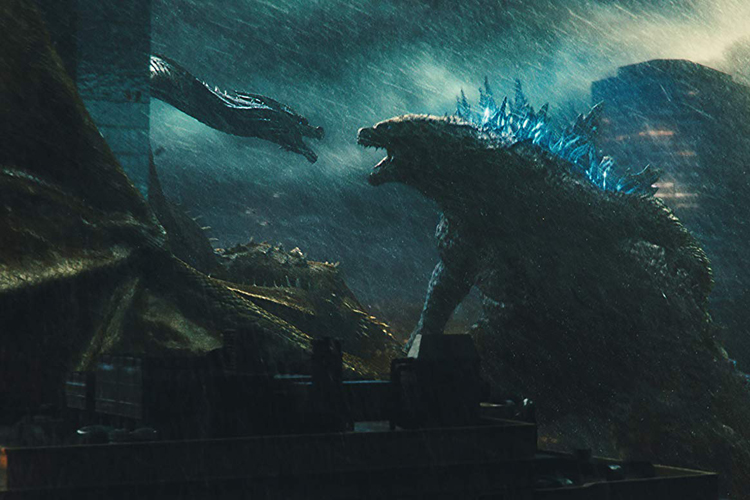Godzilla is supposed to be ancient, but extremely scientific methods tell us that his year of origin was 1954, when he first appeared in the Japanese kaiju film Gojira. That’s actually older than the Hollywood summer blockbuster—those weren’t around until the 1970s, when Hollywood changed its failing business strategy and started dumping ridiculous amounts of money into the laps of promising directors. Jaws, colloquially known as the first summer blockbuster, has something in common with Hollywood’s 2014 version of Godzilla: you don’t see the whole monster until the third act. Sequels have to up the ante, though, so Godzilla: King of the Monsters is a lot more generous with its giant beasts.
2014’s Godzilla may have taken the Jaws approach with its creature reveal, but it lacked a key element of Spielberg’s classic: interesting human characters. The tension of the slow buildup was cheapened by the bland human drama that played out in the meantime. King of the Monsters switches directors and directions in an effort to remedy that: Godzilla’s presence is well established at the beginning of the movie, and a number of kaiju—referred to here as “titans”—are popping up all over the world. The stage is set for a cavalcade of battling behemoths… right?
Well, yes, but the surrounding movie is so mind-numbingly dumb that it’s hard to enjoy the simple pleasures. To varying degrees of effort, King of the Monsters tries to make its narrative about climate change. The bad guys want to let the titans destroy humanity so that we stop poisoning the planet, and the good guys want… not that. The villains’ plan is so preposterous that Kingsman: The Secret Service, an over-the-top parody of the Bond franchise, did it five years ago. Kingsman was a comedy, though—King of the Monsters plays its environmentalism with the requisite seriousness of a gritty reboot. Sometimes the movie seems to side with the evil plot: after scenes in which titans wreck cities and end innumerable lives, there are still enthusiastic messages of “hey, look at how well those areas are healing without the dirty humans around!”
The protagonists’ motives can be just as asinine. You have your run-of-the-mill, anti-extinction-of-humanity characters—namely Kyle Chandler, in his role of average guy who looks like Kyle Chandler—but others believe that the titans will “bring balance” and solve climate change without all the mass murder. How, exactly, giant monsters are supposed to do this is not explained, given that their main skills are crushing and exploding things. And none of this even starts to get into the movie’s other titan-sized plot holes, which range in severity from “Spider-Man 3 butler saving crucial information until the last possible moment”-type mishaps to “the entire course of this movie would change if somebody followed through on a logical thought for once”.
But yes, there are some impressive kaiju battles, thanks in part to the recyclable story: humans battle titan, titan nearly kills them, another titan shows up to save the day, rinse and repeat (more than three times!). The daunting sense of scale present in Godzilla has carried over intact, but the CGI has taken a step down. You’ll have to squint to tell—King of the Monsters uses weather effects like action movies use shaky cam, obscuring subpar CGI in a haze of rain/clouds/what have you. Elsewhere in the visual department, the stunning shots showcased in the trailer have their times to shine, but nothing comes close to the artful cinematography of Kong: Skull Island.
King of the Monsters may be a disappointment, but at least it’s nothing new in the world of blockbuster sequels. Like Independence Day: Resurgence, its tone is too serious to elevate the ‘dumb’ to ‘dumb fun’, and there’s some laughable dialogue about the core of the Earth. And like Jurassic World: Fallen Kingdom, there are giant reptiles and it’s terrible.
★ (1/5)




